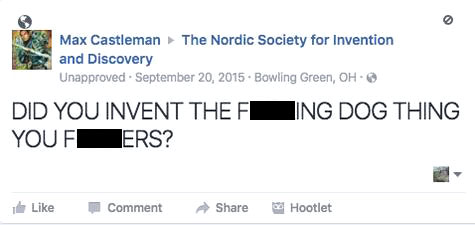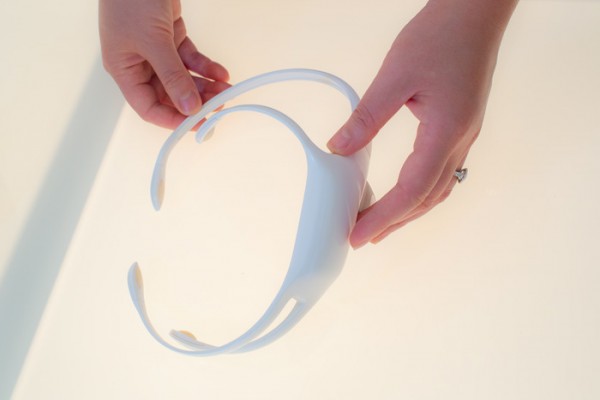Crowd funding raised money for a device to read the thoughts of dogs, but the gadget did not come out
 In December 2013, Scandinavian engineers launched a crowdfunding campaign in support of the No More Woof project. It was assumed that a team of enthusiasts will create a wearable gadget that will read dog “thoughts” and translate its mental state into human language. They were going to do this by applying the EEG brain scan technology for dogs, and thus find neural structures that correlate with feelings of fatigue, hunger, arousal and recognition. A group of researchers Nordic Society for Invention and Discovery ( NSID ) planned to release the first device by May 2014.
In December 2013, Scandinavian engineers launched a crowdfunding campaign in support of the No More Woof project. It was assumed that a team of enthusiasts will create a wearable gadget that will read dog “thoughts” and translate its mental state into human language. They were going to do this by applying the EEG brain scan technology for dogs, and thus find neural structures that correlate with feelings of fatigue, hunger, arousal and recognition. A group of researchers Nordic Society for Invention and Discovery ( NSID ) planned to release the first device by May 2014.As expected, this did not happen. The No More Woof story confirms the current state of neurotechnology products intended for consumers (as opposed to devices for medical institutions): a bold, exciting idea, but often simply unreal.
While crowdfunding failures have become a familiar part of Internet culture, NSID has a terrible connection with its sponsors. After months, and then years, NSID did not update their site and accounts in social networks until last week. Then they began, finally, to respond to comments like these:
')




The update, published last week, offers all sponsors a refund. A few days ago, NSID removed from the site all the data about this project, although a separate page devoted to No More Woof remained intact.
While the pages of No More Woof remained without updates, the technological component was developing, and engineering tasks seemed to be completely solvable. EEG signals were easy to identify, because the dogs' brains are not very complex. The problems faced by the Scandinavian developers - comfortable placement of the gadget on the dog's head and the definition of a clear signal when attaching the device to the fur.
In May 2014, shortly before the official date of delivery of the gadget, No More Woof sent out waiting letters to the gadget with the text that the project was postponed, engineers are working in laboratories and working on issues of usability and reliability, but could not even tell the approximate delivery date. They also offered to issue a refund and have not contacted customers since.
It turned out that the company spent more money on No More Woof than originally planned. In a conversation with representatives of NSID, it became known that the company had long ago turned its attention to other projects and, in principle, “forgot” that it had promised to create a “mind reader” for dogs. Hannah Mazetti, an NSID employee, justifies: "We restructured the company and we had a scattered engineer." Mazetti means Per Cromwell, one of the co-founders of NSID. He explained in a letter that his work on No More Woof had been thwarted by the economic realities of production and the difficulties in creating optimal attachment of a headset to a dog.
One of the people who invested money in this project was CJ Cornell (CJ Cornell) - an investor and a scientist, besides, "dog lover." He noted that the company left behind not the best impression, and the point is not that NSID did not make itself felt so long. Cornell is concerned about the fact that crowdfunding is gradually becoming a “pre-order”, and now it is assumed that users are buying the final product. In his opinion, this is a shame, since crowdfunding is more about investing in an idea.
Cromwell of NSID is sure that the idea of No More Woof is worth investing in, because it is based on reliable scientific data. Reading thoughts is not a problem. But a wearable EEG system cannot be a good solution as long as it cannot be worn without inconvenience.
No More Woof by its own example showed what dangers await in the path of those who are planning to raise funds for neurotechnological gadgets using crowdfunding. Neurote is a new niche for start-ups, since the mechanisms that read brain structures and electrically stimulate the brain have become cheaper and more mobile just recently.
Until recently, EEG technology was not suitable for wearable devices. Standard technology has been used for decades in neurology: all you need is to lubricate the patient's head with a conductive gel, attach the electrodes to the entire hair-covered part of the head and, taking a bundle of wires, attach the patient to the computer. Now, both researchers and startups are integrating wireless “dry” electrodes into their headbands, headphones, helmets, and caps.
A similar form of brain stimulation, micropolarization , uses head skin electrodes to send a small direct current charge to the brain. Entrepreneurial craftsmen conduct experiments at home with cheap electrodes and simple electronics, and aspiring entrepreneurs try to improve their mental abilities in various ways.

Emotiv Insight Helmet
But just because it works now doesn’t mean that you can easily create a gadget for “mind reading” or mind control. Other crowdfunding products have already caused dissatisfaction of sponsors with long-term delays while their creators are fighting for the work of their products and the launch of mass production.
Kickstarter users have been waiting for the Aurora gadget, a rim that uses an electroencephalogram to control sleep patterns and stimulate lucid dreams, for more than two years. Kokoon headphones with similar features came out a year later. Melon - the gadget that used the EEG and the application to help people focus, was still sent to customers, but later the startup was bought out, and the parent company stopped supporting the product.
Source: https://habr.com/ru/post/373099/
All Articles